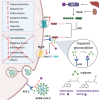Insights in Chloroquine Action: Perspectives and Implications in Malaria and COVID-19
- PMID: 32686260
- PMCID: PMC7404934
- DOI: 10.1002/cyto.a.24190
Insights in Chloroquine Action: Perspectives and Implications in Malaria and COVID-19
Abstract
Malaria is a threat to human mankind and kills about half a million people every year. On the other hand, COVID-19 resulted in several hundred thousand deaths since December 2019 and remains without an efficient and safe treatment. The antimalarials chloroquine (CQ) and its analog, hydroxychloroquine (HCQ), have been tested for COVID-19 treatment, and several conflicting evidence has been obtained. Therefore, the aim of this review was to summarize the evidence regarding action mechanisms of these compounds against Plasmodium and SARS-CoV-2 infection, together with cytometry applications. CQ and HCQ act on the renin angiotensin system, with possible implications on the cardiorespiratory system. In this context, flow and image cytometry emerge as powerful technologies to investigate the mechanism of therapeutic candidates, as well as for the identification of the immune response and prognostics of disease severity. Data from the large randomized trials support the conclusion that CQ and HCQ do not provide any clinical improvements in disease severity and progression of SARS-CoV-2 patients, as well as they do not present any solid evidence of increased serious side effects. These drugs are safe and effective antimalarials agents, but in SARS-CoV-2 patients, they need further studies in the context of clinical trials. © 2020 International Society for Advancement of Cytometry.
Keywords: Plasmodium; SARS-CoV-2; autophagy; clinical trials; renin angiotensin system; side effect; viral invasion.
© 2020 International Society for Advancement of Cytometry.
Conflict of interest statement
The authors declare that there are no conflicts of interest regarding the publication of this paper.
Figures



Similar articles
-
Chloroquine and hydroxychloroquine in the treatment of malaria and repurposing in treating COVID-19.Pharmacol Ther. 2020 Dec;216:107672. doi: 10.1016/j.pharmthera.2020.107672. Epub 2020 Sep 8. Pharmacol Ther. 2020. PMID: 32910933 Free PMC article. Review.
-
A systematic review of the prophylactic role of chloroquine and hydroxychloroquine in coronavirus disease-19 (COVID-19).Int J Rheum Dis. 2020 May;23(5):613-619. doi: 10.1111/1756-185X.13842. Epub 2020 Apr 27. Int J Rheum Dis. 2020. PMID: 32281213 Free PMC article.
-
COVID-19 Pandemic - A Narrative Review of the Potential Roles of Chloroquine and Hydroxychloroquine.Pain Physician. 2020 Aug;23(4S):S351-S366. Pain Physician. 2020. PMID: 32942793 Review.
-
Therapeutic use of chloroquine and hydroxychloroquine in COVID-19 and other viral infections: A narrative review.Travel Med Infect Dis. 2020 May-Jun;35:101735. doi: 10.1016/j.tmaid.2020.101735. Epub 2020 May 6. Travel Med Infect Dis. 2020. PMID: 32387694 Free PMC article. Review.
-
A pharmacological perspective of chloroquine in SARS-CoV-2 infection: An old drug for the fight against a new coronavirus?Int J Antimicrob Agents. 2020 Sep;56(3):106078. doi: 10.1016/j.ijantimicag.2020.106078. Epub 2020 Jul 4. Int J Antimicrob Agents. 2020. PMID: 32629115 Free PMC article. Review.
Cited by
-
Hyperactivation of P2X7 receptors as a culprit of COVID-19 neuropathology.Mol Psychiatry. 2021 Apr;26(4):1044-1059. doi: 10.1038/s41380-020-00965-3. Epub 2020 Dec 16. Mol Psychiatry. 2021. PMID: 33328588 Free PMC article. Review.
-
Virus adaptation to heparan sulfate comes with capsid stability tradeoff.Elife. 2024 Dec 23;13:e98441. doi: 10.7554/eLife.98441. Elife. 2024. PMID: 39714930 Free PMC article.
-
G6PD deficiency, redox homeostasis, and viral infections: implications for SARS-CoV-2 (COVID-19).Free Radic Res. 2021 Apr;55(4):364-374. doi: 10.1080/10715762.2020.1866757. Epub 2021 Jan 6. Free Radic Res. 2021. PMID: 33401987 Free PMC article. Review.
-
Can a metabolism-targeted therapeutic intervention successfully subjugate SARS-COV-2? A scientific rational.Biomed Pharmacother. 2020 Nov;131:110694. doi: 10.1016/j.biopha.2020.110694. Epub 2020 Aug 27. Biomed Pharmacother. 2020. PMID: 32920511 Free PMC article. Review.
-
Antimalarial compounds exhibit variant- and cell-type-specific activity against SARS-CoV-2 isolated in Panama.Front Pharmacol. 2025 Jun 4;16:1537053. doi: 10.3389/fphar.2025.1537053. eCollection 2025. Front Pharmacol. 2025. PMID: 40535766 Free PMC article.
References
-
- Gorka AP, Dios A, Roepe PD. Quinoline drug‐Heme interactions and implications for antimalarial cytostatic versus cytocidal activities. J Med Chem 2013;56:5231–5246. - PubMed
-
- Müller IB, Hyde JE. Antimalarial drugs: Modes of action and mechanisms of parasite resistance. Future Microbiol 2010;5:1857–1873. - PubMed
-
- WHO, List 2019 . World Health Organization model list of essential medicines: 21st List 2019. 2019. https://apps.who.int/iris/handle/10665/325771.
-
- Kaur K, Jain M, Reddy RP, Jain R. Quinolines and structurally related heterocycles as antimalarials. Eur J Med Chem 2010;45:3245–3264. - PubMed
Publication types
MeSH terms
Substances
Grants and funding
- Coordenação de Aperfeiçoamento de Pessoal de Nível Superior/International
- Fundação de Amparo à Pesquisa do Estado do Rio Grande do Sul/International
- Conselho Nacional de Desenvolvimento Científico e Tecnológico/International
- São Paulo Research Foundation/International
- 2015/19128-2/Fundação de Amparo à Pesquisa do Estado de São Paulo/International
LinkOut - more resources
Full Text Sources
Medical
Miscellaneous

